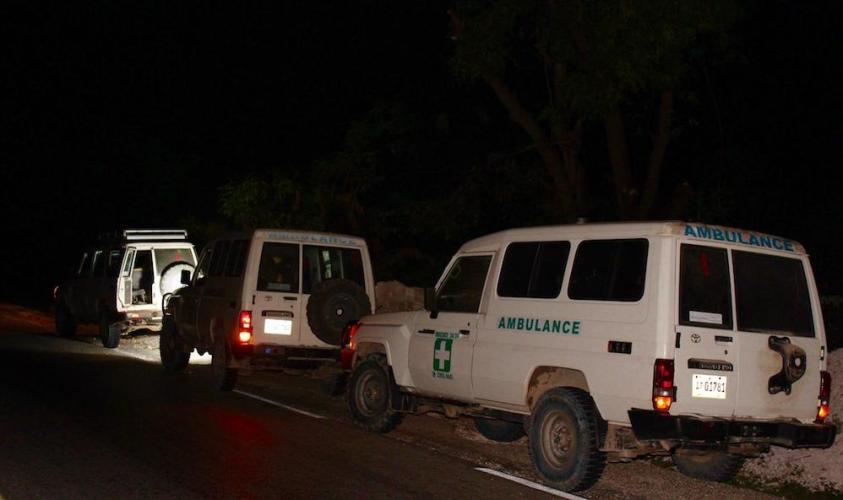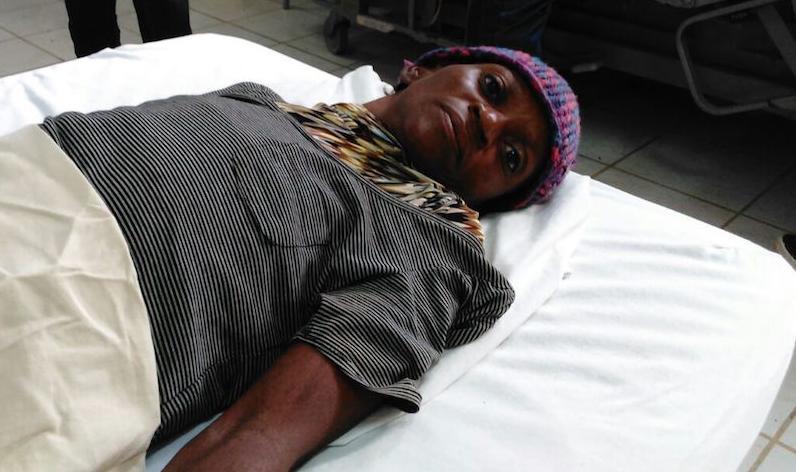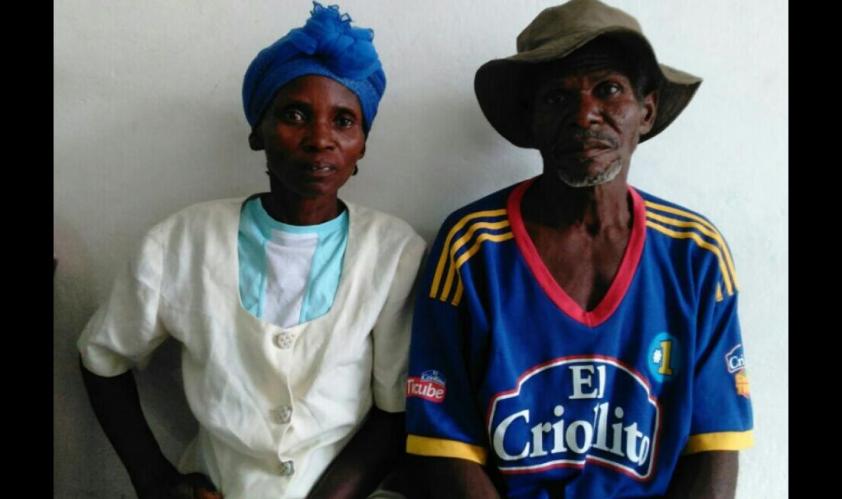“We value making patients feel welcome.”
Your donation will help Nurse Laguerre provide the highest-quality care to every patient in need.


Ambulances head to Les Cayes by dark.
On the afternoon of October 12, 2016—eight days after Hurricane Matthew devastated the southern peninsula of Haiti - Dr. Samuel Bernard, Medical Director of SBH in Fond des Blancs, Haiti, received a call from the International Medical Corps (IMC). “There are six patients sitting outside of OFATMA hospital in Les Cayes. They are unable to receive medical treatment here. Each has wounds they sustained from the hurricane that are now infected. Can St. Boniface take them in?”
But transporting patients across roads that are still in terrible condition after the storm was no easy feat. Driving that route in the dark is treacherous under normal conditions. In the aftermath of the hurricane, which caused major washouts and damage to roads throughout the region, it would be much harder.
Despite the danger, the hospital mobilized to get to the patients in need. “We were unsure of their condition,” says COO Bill Gimson, “and decided to assemble three of our ambulances to head to Les Cayes that night.” A small team joined the ambulances: Dr. Bernard, Bill Gimson, and Emergency Room Director Dr. Danica Gomes, to assess not only the six patients but also the situation at the hospital in Les Cayes.
The team left at 9:30 at night, driving two hours on the dark, dirt roads still washed out from Hurricane Matthew. Upon arrival, two IMC members greeted the SBH team and lead them to the group of hurricane survivors sitting outside the hospital. Each had significant wounds, and terrifying stories to tell.

Charlisena Lubin is lifted into a SBH ambulance.
Most tragic is Charlisena Lubin, the 14-year-old girl from Les Cayes who is now paralyzed from the waist down. Her father described the horror, “A branch, knocked loose by the wind and rain, fell on her. As she tried to stand up again, another branch fell. She couldn’t stand again afterward.” Charlisena Lubin’s health is otherwise stable—she has not sustained the same infections as the rest of her group. She is well enough to begin physical therapy today at SBH’s Spinal Cord Injury Rehabilitation Center.
These are old wounds—you are not supposed to close old wounds. But we had no other choice here.
Dr. Danica Gomes, SBH Emergency Department
Rameau Augustin, 85 years old from Les Cayes, came to the hospital with an enormous gash across his skull. The flesh was necrotic, making the gash grow larger. The tip of his nose, nearly severed by flying debris in the storm, was hanging by a fragment of skin. “These are old wounds” explains Dr. Gomes “you are not supposed to close old wounds. But we had no other choice here. So he is on antibiotics to avoid further infection.” His wounds are wrapped and his nose sutured back into place.
Rameau’s story is similar to every other patient who came from Les Cayes to SBH. They are suffering from painful wounds received on the night of the hurricane, which went untreated for over a week because most hospitals on the Southwestern tip of Haiti are not functioning in the aftermath of the storm.

Anie Rosaino rests at SBH.
Anie Rosaino, age unknown, is missing most of the skin from the top of her right foot—her bone was visible through her wound. Anie comes from Les Anglais, one of the towns along the west coast of the southern peninsula that was nearly entirely destroyed in the storm. It took four days for the first outsiders—two members of SBH’s team—to even reach Les Anglais.
Marie Villaire Dumez, who is also from Les Anglais and does not know her age, sustained a puncture to her foot that became infected. The infection was allowed to persist and spread all the way to her knee. She is also being observed closely and taking antibiotics to treat and prevent further infection.

Claudette and Balize Joseph at SBH.
The final patient from Les Anglais, Claudette Joseph, is 80 years old and was accompanied by her husband, Balize Tilis. Claudette also has a puncture wound in her foot that had become severely infected. Nurses must continually drain the huge accumulation of pus.
After Dr. Gomes explained each patient’s condition, she ended by saying that they all arrived with extremely low blood sugar. This is an indication that none had eaten for a long time. Here at St. Boniface, these six patients have access to regular care and observation not available at every Haitian hospital. For Charlisena especially, St. Boniface is the best hospital for her needs – access to one of Haiti’s few Physical Therapists and a compassionate team who is well equipped to handle the physical and emotional stress of learning how to live life fully in a wheelchair.
The situation in southwestern Haiti is dire, as our six patients who came from the hardest-hit area can personally attest. St. Boniface Hospital is proud to be able to provide high quality, comprehensive care to Rameau, Michelange, Anie, Marie, Claudette, Charlisena, and all of the patients who come to us in need of care.
Your donation will help Nurse Laguerre provide the highest-quality care to every patient in need.
